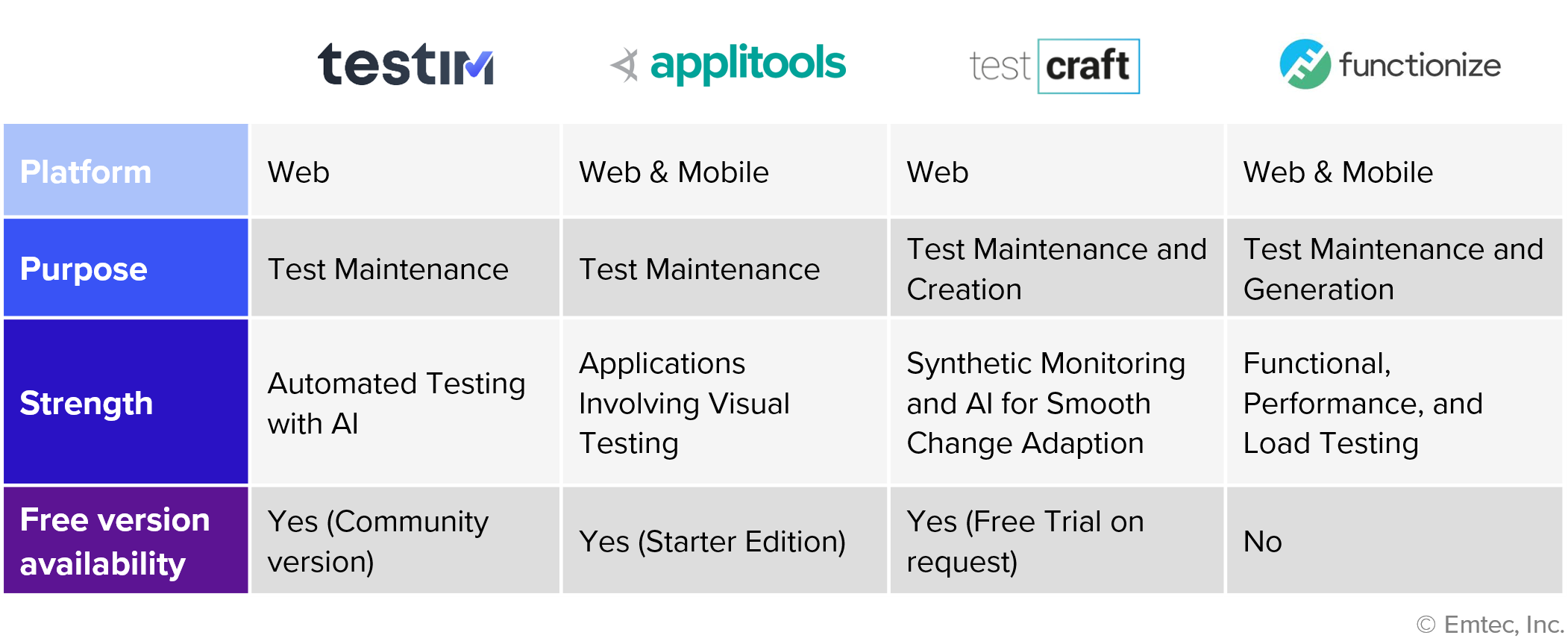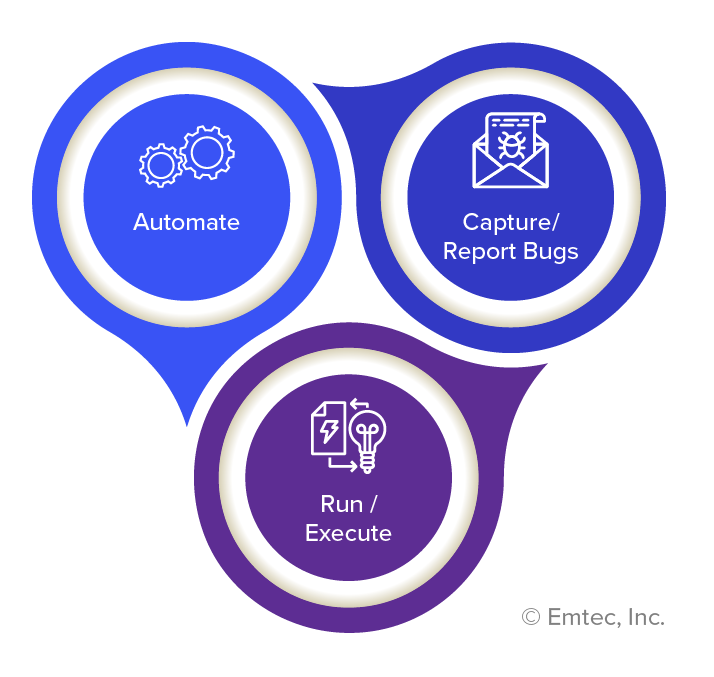Artificial Intelligence (AI) found a way to not only improve software development, but also the quality assurance (QA) process. Here is how AI-led QA is impacting global businesses –

AI is expected to add an astounding $15.7 trillion to the global economy by 2030.* Soon, AI-focused spending will be one of the fastest-growing technology trends in software development.
The software quality assurance space will also reap tangible benefits with AI-based tools by automating manual effort and accelerating sprints during the SDLC. Other notable advantages include –
- Identifying duplicate test cases and optimizing the test suite
- Identifying high-risk and glitch prone areas of an application to improve regression testing
- Analyzing historical data to predict key test parameters for future tests
- Analyzing social media data from customers and offering a comprehensive feedback report detailing critical pain areas
- Executing test cases automatically by identifying the hotspots
The success of an AI-based QA tool can be determined by how much it simplifies an application engineer’s tasks with valuable traits such as –
- Features & Functionality: Should support your automation requirements regarding application development and quality assurance.
- Value for Money: Should be priced based on the features, capabilities, and use cases it provides. It should generate faster ROI by aiding in rapid product development and swift updates.
- Usability: Should require optimal programming skills and be easy to learn. The best tools have good tech support, user support, tutorials, and training.
- User Interface (UI): Needs to be clean and attractive.
- Integrations: The best tools are easy to connect with other tools and plugins. Look for tools with pre-built integrations that integrate with bug tracking tools (e.g., JIRA), and support various operating systems and browsers (e.g., Internet Explorer, Google Chrome, Safari, Firefox).
- Documentation: Must have a clear and robust documentation process with easily retrievable and exportable test results.
- Script Languages: The tool should support a variety of popular scripting languages or specialize and go quite deep in one script language.
- Version Control: Software testing needs to be done on multiple files at once. The tool should store and display the data history to revert to local changes if needed.
- Test Commands: The tool should support several test commands and allow users to add, change and test commands as needed.
- Test Scenarios: The software should support a variety of test scenarios, including performance testing.
The technology space is inundated with a variety of AI-based QA tools – all with their own unique features. Here is a brief overview of the four most popular AI tools used in software quality assurance.

- Testim
Testim is an AI-based software testing platform that allows users to create resilient end-to-end tests that are either coded or codeless or both. The success and popularity of Testim lies with its original cyclic model.

Feature highlights
- Smart Locators: Smart Locators enable multiple users/teams to work on one single application by allowing users to select and change a specific item. This selected item assigns unique attributes to the element and allows the tool to learn with each test run. This way, if the element is changed but still functioning, Smart Locators find it and keep the test from failing.
- Dynamic Locators: These use multiple attributes of an element to locate it on the page. This way, even if one attribute changes, the element can still be successfully located with the help of other attributes that have already been extracted from the DOM by the AI.
- Groups: Steps can be grouped and reused. Grouping helps architects test by avoiding the creation of repeated steps. We can also create a more efficient test architecture by reusing proven steps.
- Validations: This helps ensure that the test output matches with the expected output. We can configure validations for data, PDFs, email, Word docs, and much more.
- Conditions: Configure a step or group of steps to run (or skip) if certain conditions are met (or absent).
- Loops: Run the same step multiple times until you get the expected output.
- Data Driven Testing: Integrates test data to push input or boundary conditions. Link a CSV, Excel, or JSON file to reference the data.
- Applitools
Applitools is the best tool for applications involving visual testing.
- Visual Testing: It finds visual bugs in apps and makes sure that no visual elements are overlapping, invisible, or off page or no new unexpected elements have appeared. Traditional functional tests cannot perform these tasks.
- Applitools Eyes: This feature scans application screens and analyzes them like a human would, but with the power of a machine. It catches material differences and identifies / ignores those which are not. This helps particularly in the areas of DevOps, Digital Transformation, manual QA, engineering, and more.
- TestCraft
TestCraft is an AI-powered test automation platform for regression and continuous testing that works on top of Selenium. It is also used for monitoring web applications. QA Engineers can visually create automated, Selenium-based tests using a drag and drop interface and run these on multiple browsers and work environments simultaneously.
- On-the-Fly Mode: It creates a test model out of your test scenario instead of a recording. This test model makes it easier to reuse test steps and apply changes as needed. Any change to a test step will apply automatically to all other scenarios that use it, reducing test maintenance time dramatically. This helps the tester achieve the best of both worlds of automated test creation – simplicity and scalability.
- Machine Learning Algorithm: It identifies web elements by collecting all possible data on all web page elements at a given time. These attributes are then fed into the algorithm, which determines the most probable element that it should be looking for in any given run. This helps the platform identify the web element correctly even when a web application change occurs.
- Self-healing Technology: It allows the platform to overcome changes, such as an enlarged signup button or a form that has moved to a different location and prevent unnecessary test breakages. This helps reduce test maintenance time dramatically.
- Functionize
Functionize is a one stop shop for test creation, execution, maintenance, and analytics, with capabilities for functional, visual, performance and load testing.
Feature highlights
- Machine Learning and Artificial Intelligence: Accelerates test creation, diagnosis, and maintenance. Once tests are built, ML models update these as an application changes, saving the tedium of constantly updating/maintaining scripts for minor UI or style changes. The tool is fast, efficient, and easy to use. It runs thousands of tests in minutes from either mobile or desktop browsers.
- Test creation through Natural Language Processing (NLP): Using keywords such as open URL, input text, verify, etc., the engine uses “automated test creation techniques” and manually created tests to identify inputs, assertions, and interactions.
- CV-based Visual Testing: CV-based visual testing is facilitated with the aid of convolutional neural networks (CNNs) and analytics to report relevant changes. It enables enterprise teams to rapidly accelerate software development while eliminating traditional test scripts, test maintenance and the need for a large QA team.
Amid quality services and service qualities
The possibilities of using AI in software quality assurance are abundant, and have garnered attention from large enterprises including –
- Salesforce, JFrog, JPMorgan, USA today (Testim)
- Bank of America, Microsoft, Intuit, Johnson and Johnson, Sony (Applitools)
- HP, Wipro, MasterCard, Cisco, The General Insurance, Hyundai, Philips (Functionize)
- Other reputable firms in the Insurance and E-commerce domain (TestCraft)
The choice of tools, however, remains requirement driven. Your critical business needs will drive your technology choice. It could be a superior user interface or ease of use (no coding needed/less maintenance) or a seamless user experience (access to multiple users, rapid results, accuracy) or budgetary constraints (licenses, subscriptions, upgraded versions).
Bridgenext’s expert team can help you meet your software development and quality assurance requirements. Contact us to learn more about digital innovation for your business.
Reference
* PwC, 2017, “Sizing the prize: What’s the real value of AI for your business and how can you capitalize?”



